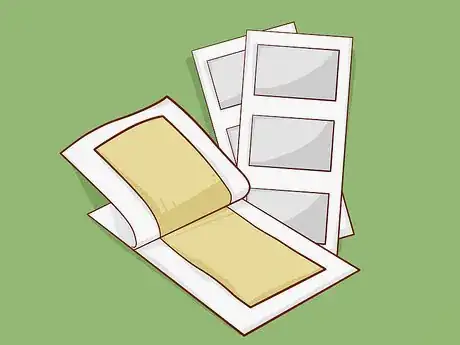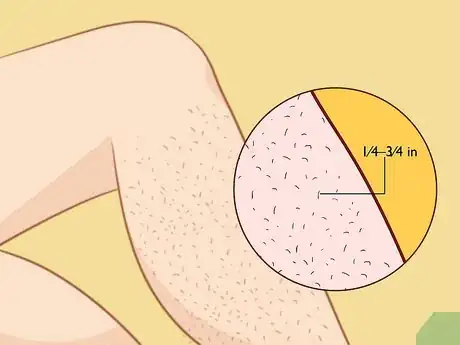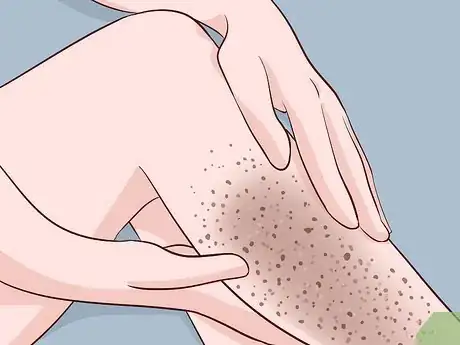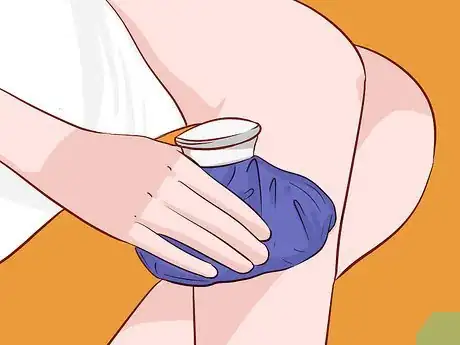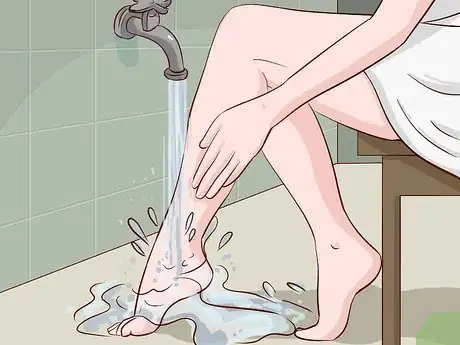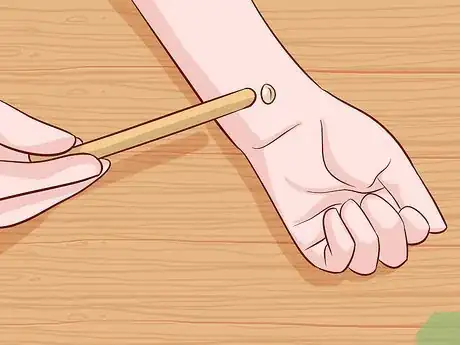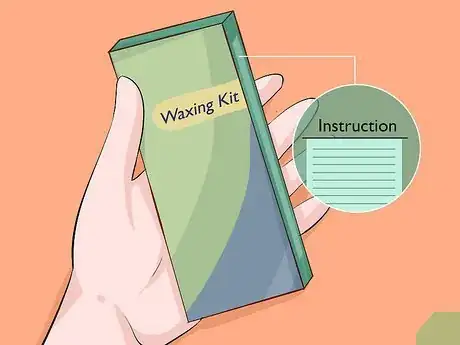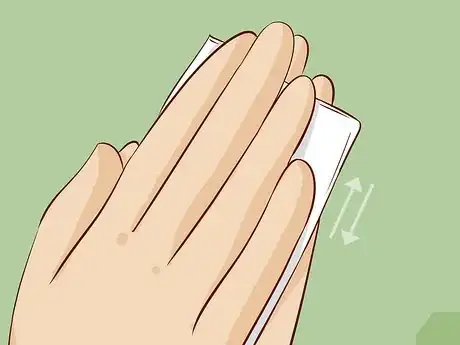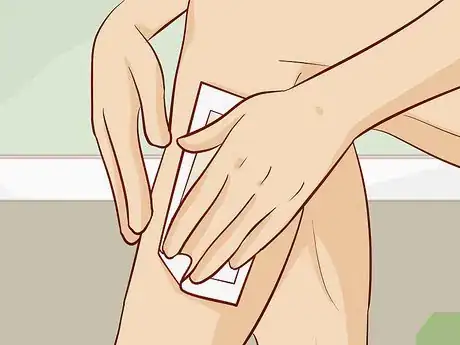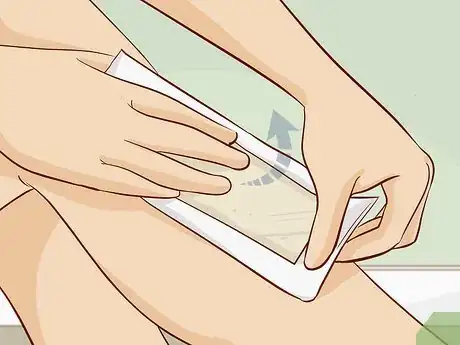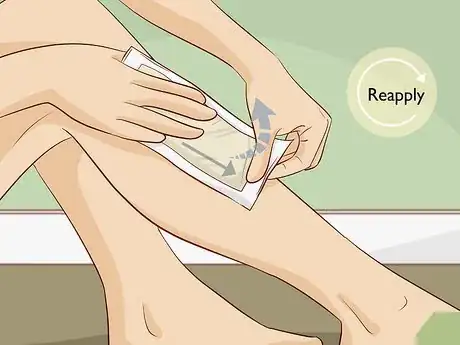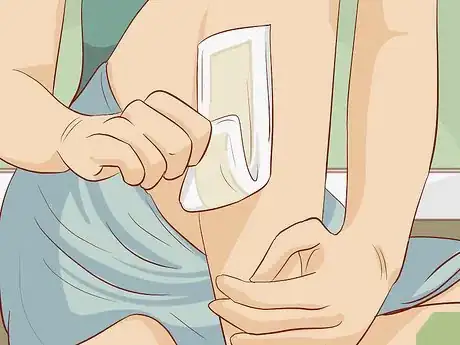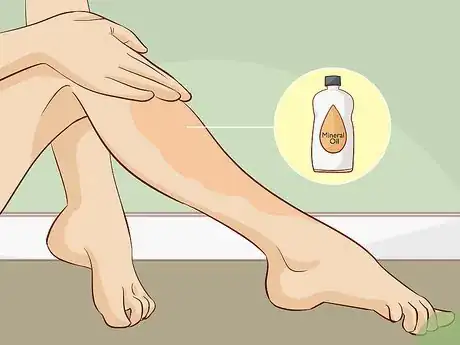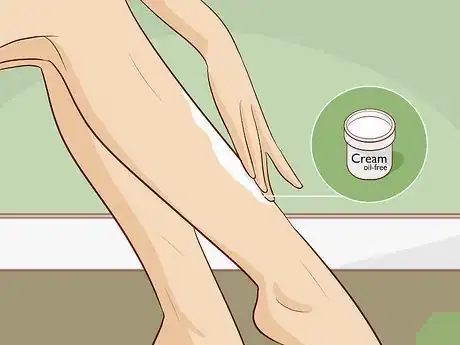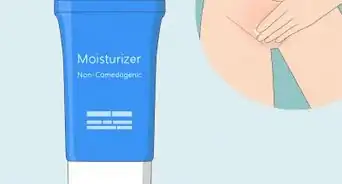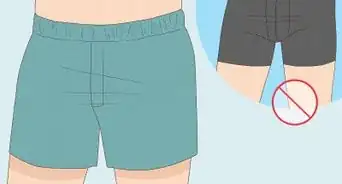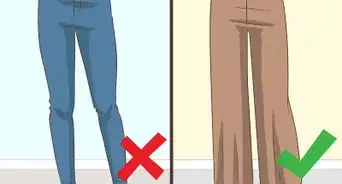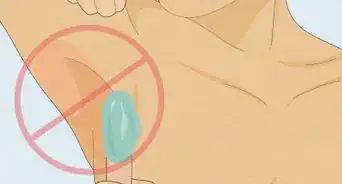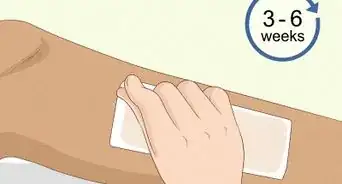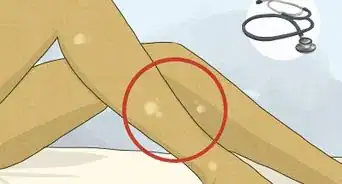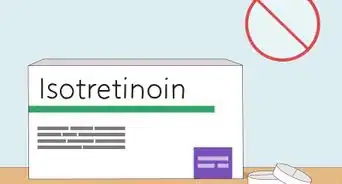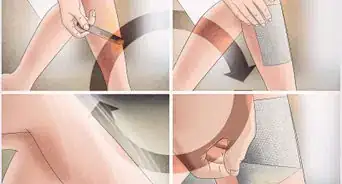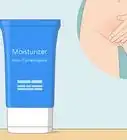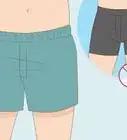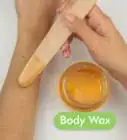This article was co-authored by Melissa Jannes. Melissa Jannes is a Licensed Esthetician and the owner of Maebee's Beauty Studio in Philadelphia, a single practitioner space providing quality services with individualized attention. Melissa is also a National Educator for Universal Companies. She received her esthetics degree at The Beauty School of Middletown in 2008 and is licensed in both New York and Pennsylvania. Melissa won the "Best of Beauty" award from Allure magazine in 2012 for the quality of her bikini waxing.
There are 7 references cited in this article, which can be found at the bottom of the page.
This article has been viewed 61,289 times.
Waxing at home may seem intimidating, but it’s actually quite easy and there are many ways to make it less painful and more comfortable. At-home waxing kits come with wax strips already covered in the proper amount of wax, so you don’t have to worry about heating any wax and applying the right amount to your skin. Plus, waxing at home is much less expensive than having it professionally done at a salon or spa and you’ll get the same results with practice.
Steps
Getting Your Skin Ready for Waxing
-
1Purchase an at-home waxing kit designed for what you want to wax. At-home waxing kits, in general, are made to wax specific parts of your body. To ensure the best results, less pain, and no irritation, make sure you purchase a kit designed for what you want to wax. For example, don’t use the same waxing kit on your face that you’d use on your underarms. Also, if you have sensitive skin, look for a kit that’s gentle or designed for sensitive skin.[1]
- If you have any kind of skin condition or disease, you should see a professional rather than attempt to do it yourself.
-
2Check that the hair you want to wax is 1⁄4–3⁄4 in (0.64–1.91 cm) long. In order to safely wax, no matter where it’s located on your body, that hair needs to be at least 1⁄4 in (0.64 cm) long, but no longer than 3⁄4 in (1.9 cm). If your hair is longer than 3⁄4 in (1.9 cm), use electric clippers or scissors to shorten your hair down to at least 3⁄4 in (1.9 cm). If your hair is shorter than 1⁄4 in (0.64 cm), wait for it to grow longer before waxing it.[2]
- Electric clippers are the type of clippers normally used to cut hair. They typically have different guards that go on the blade so you can cut your hair to a specific length.
Advertisement -
3Stop using products with retinol 2-5 days before waxing. If you’re taking any type of prescription medication that contains retinol, or if you’re using any skin products that contain retinol, stop using them at least 2 days before you wax. Do not wax while taking or using these products.[3]
- In general, retinol products can dry and irritate your skin; make it peel, crust or blister; and make it sensitive to sunlight.[4]
- Waxing your skin while taking retinol products can make these side effects worse and damage your skin.
-
4Exfoliate the area you plan to wax 1-2 days in advance. To get the best waxing results, remove dry or dead skin and other imperfections ahead of time. A couple of days before you plan to wax, wash and exfoliate the area you’re going to wax.[5] Do not exfoliate within 24 hours of waxing, as it may irritate your skin.[6]
- Exfoliation includes using a brush, face cloth, loofa, etc., to scrub your skin.
- You can also use specific exfoliation products, such as body/face scrubs, that contain small, rough pieces of things like seeds to help exfoliate your skin.[7]
-
5Drink lots of water before you start to wax. Make sure you’re completely hydrated before you wax. Drink as much water as you can in the hours before you’re going to wax. Hydration plumps up your skin which can reduce the amount of pain. Plus, plump, hydrated skin is less likely to get ingrown hairs.[8]
- Try to avoid foods and drinks that can dehydrate you before you wax, such as coffee, soda, alcohol, fried foods, and anything with a lot of sodium/salt.
-
6Take pain medications or apply ice to reduce pain. You will never be able to eliminate the pain from waxing completely, but there are things you can do to reduce that pain. Take an over-the-counter pain medication an hour or 2 before you wax. Or, hold an ice pack against the skin you’re going to wax immediately beforehand to numb the area.[9]
- If you use an ice pack, hold a towel between that ice pack and your skin. Also, make sure the area is completely dry before applying the wax.
- You can also apply an ice pack to the area after you wax to reduce the pain.
-
7Wash and dry the area you’re waxing immediately beforehand. Right before you wax, completely wash the area with soap and water and dry your skin with a towel. If possible, have a shower immediately before you wax. You want to remove natural oils that may be on your skin and/or the residue of lotions or creams you may have recently applied. Wax adheres better to clean, dry skin.[10]
- Some at-home wax kits come with a pre-wax cleanser that you can use to wipe down the area you’re going to wax.
- If you aren’t able to wash the area before you wax, sprinkle baby powder (or another powder like cornstarch) onto your skin to absorb the oils.[11]
-
8Conduct a test run of the wax to make sure it’s safe. Follow the regular instructions to try small amount of wax on a 1 by 1 in (2.5 by 2.5 cm) piece of your skin. If the waxing kit doesn’t come with a test strip, cut a small piece off one of the larger strips. Use a spot on your body that isn’t visible in case the wax irritates your skin (e.g., upper arm or upper leg).[12]
- If the test area becomes really red, swollen, painful, or irritated, don’t use the wax anywhere else on your body.
Using Wax Strips to Remove Hair
-
1Read the manufacturer’s instructions before using the wax strips. Do not attempt to wax until you’ve read all the instructions and warnings that come with the kit (unless you’ve used the product before). Make sure you know exactly which items you’ll need to have ready when waxing and gather those items before you start.[13]
- In general, you’ll likely need the following items to wax: a brightly lit room, a mirror (depending on where you’re waxing), a towel, moisturizer or aloe vera, and tweezers (if you’re waxing your face).
-
2Remove the protective backing from the prepared wax strip. You can approach this step two ways.You can remove the entire backing off the strip before applying the strip to your skin. Or, you can peel off a portion of the backing, apply that part of the strip to your skin, and then pull off the rest of the backing as you push the strip against your skin.[14]
- Some at-home waxing kits may instruct you to rub the strips between your hands for a few seconds before removing the back. This is to heat the wax slightly before you apply it to your skin.
-
3Apply the wax strip to your skin and rub it 2-3 times. Lay the wax strip down on the area you’re waxing, in a direction that will allow you to easily pull the strip off in the opposite direction of your hair’s growth. For example, when waxing your legs, you’ll want to lay the strips lengthwise on your legs. When waxing your eyebrows, you’ll want to lay the strips horizontally above your eyes. Rub your hand along the wax strip in the direction of the hair growth 2-3 times to firmly secure it to your hair.[15]
- Keep in mind that the wax doesn’t go to the edge of the strips. Therefore, the unwaxed edges of the strips will need to be located where there’s no hair or where you’ve already waxed.
-
4Use one hand to hold the skin taut to pull off the strip. You’ll always need 2 hands to pull off a wax strip: one hand to hold your skin tight while the other hand rips off the strip. You’ll find it easier to use your dominant hand to rip off the strip, unless you’re waxing an area that’s difficult to reach. Practice makes perfect when it comes to waxing. You may need to reposition yourself several times before you find your favourite method.[16]
- This is one of the reasons it’s best to wax larger areas that are easier to see (e.g., your legs) if this is your first time waxing at home.
-
5Rip the wax strip off quickly in the opposite direction of hair growth. Grasp the edge of the wax strip at the end your hair is growing towards. For example, if you’re waxing your legs, you’ll want to grab the bottom of the wax strip as you’ll be pulling upwards. Hold the strip firmly and pull in the opposite direction of the hair growth quickly and in one motion.[17]
- Try to remove the entire wax strip in one smooth movement.
- Don’t stop and restart partway through pulling off a wax strip, this will just cause you more pain and won’t pull out as many hairs.
-
6Reapply the wax strip up to 2 more times to remove stray hairs. Each wax strip can be applied to your skin up to 3 times if needed. That means, after the first pull, you can re-wax the same area 2 more times if you missed any hairs. It’s not a good idea to apply wax to the same area more than this, as it may cause too much irritation.[18]
- You can also use the wax strip to remove any wax residue on your skin. Apply the strip and remove it the same way you would if it were hair.
-
7Repeat the process for the remaining areas. Once you’ve completed the waxing process using one strip, continue the same process with new strips until the area is fully waxed. If the section you need to wax doesn’t need a full strip, feel free to cut the strip into smaller pieces so you don’t waste any.[19]
- Larger areas, like legs and arms, will require multiple wax strips.
- Smaller areas, like your upper lip or eyebrows, may only require 1 strip.
-
8Remove any remaining wax off your skin with water or oil. Check the manufacturer’s instructions to determine the recommended method to remove residual wax from your skin (if there is any). Some at-home waxing kits are water-soluble, which means you can easily wipe the leftover wax off with a damp washcloth. Other kits are oil-soluble, which means you will need to use some sort of oil (e.g., mineral oil, coconut oil, etc.) to remove the wax residue. Dab a small amount of oil onto a makeup pad and wipe the wax off your skin.[20]
- Some at-home waxing kits will come with a product that’s specifically for removing residual wax from your skin.
-
9Moisturize the area just waxed with oil-free lotion or cream. Once you’ve finished waxing and have cleaned up all the wax residue, make sure your skin is completely moisturized. Use a lotion or cream that is oil-free or non-comedogenic so it doesn’t clog your pores and potentially cause ingrown hairs. You can also use aloe vera gel to soothe the area and add moisture if you’d prefer.[21]
- It is also recommended that you wear loose-fitting clothing around the waxed area immediately afterward to prevent skin irritation.
- Avoid having a hot shower or bath immediately after waxing, as it may make the area more painful.
Expert Q&A
-
QuestionCan face scrub be used as a body scrub?
 Melissa JannesMelissa Jannes is a Licensed Esthetician and the owner of Maebee's Beauty Studio in Philadelphia, a single practitioner space providing quality services with individualized attention. Melissa is also a National Educator for Universal Companies. She received her esthetics degree at The Beauty School of Middletown in 2008 and is licensed in both New York and Pennsylvania. Melissa won the "Best of Beauty" award from Allure magazine in 2012 for the quality of her bikini waxing.
Melissa JannesMelissa Jannes is a Licensed Esthetician and the owner of Maebee's Beauty Studio in Philadelphia, a single practitioner space providing quality services with individualized attention. Melissa is also a National Educator for Universal Companies. She received her esthetics degree at The Beauty School of Middletown in 2008 and is licensed in both New York and Pennsylvania. Melissa won the "Best of Beauty" award from Allure magazine in 2012 for the quality of her bikini waxing.
Licensed Esthetician & Brazilian Wax Educator Yes, you can use face scrub to exfoliate your body. Use a face scrub that has a gritty texture.
Yes, you can use face scrub to exfoliate your body. Use a face scrub that has a gritty texture.
Things You’ll Need
- Scissors
- Electric clippers
- Loofa, washcloth, etc.
- Exfoliant product
- Soap
- At-home waxing kit
- Oil-free or non-comedogenic moisturizer
- Over-the-counter pain medications (optional)
- Ice pack (optional)
- Aloe vera gel (optional)
References
- ↑ https://www.self.com/story/how-to-wax-at-home
- ↑ https://www.aad.org/public/everyday-care/skin-care-basics/hair/how-to-wax
- ↑ https://www.aad.org/public/everyday-care/skin-care-basics/hair/how-to-wax
- ↑ https://www.health.harvard.edu/staying-healthy/do-retinoids-really-reduce-wrinkles
- ↑ Melissa Jannes. Licensed Esthetician. Expert Interview. 30 August 2019.
- ↑ https://www.marieclaire.co.uk/life/health-fitness/waxing-at-home-595317
- ↑ Melissa Jannes. Licensed Esthetician. Expert Interview. 30 August 2019.
- ↑ https://www.self.com/story/how-to-wax-at-home
- ↑ https://www.aad.org/public/everyday-care/skin-care-basics/hair/how-to-wax
- ↑ https://www.marieclaire.co.uk/life/health-fitness/waxing-at-home-595317
- ↑ https://www.marieclaire.com/beauty/hair/a1780/waxing-tips/
- ↑ https://www.self.com/story/how-to-wax-at-home
- ↑ https://www.marieclaire.com/beauty/hair/a1780/waxing-tips/
- ↑ https://www.self.com/story/how-to-wax-at-home
- ↑ https://www.marieclaire.com/beauty/hair/a1780/waxing-tips/
- ↑ https://www.self.com/story/how-to-wax-at-home
- ↑ https://www.marieclaire.co.uk/life/health-fitness/waxing-at-home-595317
- ↑ https://www.marieclaire.com/beauty/hair/a1780/waxing-tips/
- ↑ https://www.marieclaire.com/beauty/hair/a1780/waxing-tips/
- ↑ https://www.self.com/story/how-to-wax-at-home
- ↑ https://www.aad.org/public/everyday-care/skin-care-basics/hair/how-to-wax
